From Hydrometeor Size Distribution Measurements to Projections of Wind Turbine Blade Leading-Edge Erosion
Abstract
1. Introduction
- Quantify and characterize differences in hydrometeor DSD due to disdrometer metrology and illustrate the influence of those differences and key data processing decisions on resulting hydrometeor size distributions and rainfall rates.
- Estimate annual average kinetic energy transfer to blades from hydrometeor impacts and quantify uncertainty due to disdrometer metrology.
- Estimate wind turbine blade lifetimes using the Springer model [49] and quantify uncertainty due to disdrometer metrology.
- Evaluate the degree to which highly erosive events are concentrated in time and attributable to the occurrence of hail.
- Evaluate cost effectiveness of the erosion-safe mode, and the influence of disdrometer metrology on the optical erosion-safe mode curtailment strategy.
2. Materials and Methods
2.1. Overview of Research Methodology
2.2. Disdrometer Measurements
2.3. Lidar Wind Speeds and Wind Turbine Power and RPM Curve
2.4. Kinetic Energy of Impacts
2.5. Modeling the Blade Lifetimes
2.6. Modeling the Impact of Erosion-Safe Mode on LCoE
- Capital expenditures (CAPEX) for a 3 MW wind turbine = USD 4,386,000 and occur only in year 1 (n = 1). This value is based on capital expenditure of 1462 per kW for a land-based reference project using 2.8 MW wind turbines, used in the recent analysis of 2020 review of the costs of wind energy [70]. It is at the higher end of global mean values in 2020, which ranged from 1050 to 1450 USD/kW [71].
- Fixed annual Operations and Maintenance (O&M) costs for a 3 MW wind turbine = USD 129,000. This value is based on O&M costs of 43 USD/kW/yr for a land-based reference project using 2.8 MW wind turbines, used in the recent analysis of the 2020 review of the costs of wind energy [70]. It assumed that these O&M costs do not include those associated with blade failure and replacement. The rate of 43 USD/KW/yr is at the mid-point of estimates (33–59 USD/kW/yr) for recently commissioned projects in a survey of US industry professionals performed in 2018–2019 [72].
- Annual discount rate (r) = 0.0523. This rate is used as a reference rate in the 2020 review of the costs of wind energy [70].
- The wind turbine lifetime is 25 years (i.e., i = 25). This project lifetime is used as a reference in the 2020 review of the costs of wind energy [70], and is consistent with expected lifetimes for many projects operating in the US. It is longer than the estimate of 20 years used in an analysis of lifetime extension of onshore wind turbines in Europe [73], but shorter than the 29.6 years derived from a recent survey of US wind industry professionals [74].
- The damage is sufficient to merit total blade replacement, and the additional O&M expenditures for replacement of a blade = USD 200,000 [75] occur in that year.
- Replacement of blades leads to 7 days of lost annual energy production (AEP). This is based on the information that most repairs take 1–3 days [75] and crews and specialist equipment may not be immediately available and/or prevailing meteorological conditions may limit turbine access. The reduction of AEP in the year when the replacement is modeled to occur is taken as 1/52 of total AEP.
3. Results
3.1. Rainfall Rates and Hydrometeor Size Distributions
3.2. Impact Kinetic Energies
3.3. Blade Lifetimes from the Springer Model
3.4. LCoE and Erosion-Safe Mode
4. Discussion
- Quantify and characterize differences in hydrometeor DSD due to disdrometer metrology and illustrate the influence of those differences and key data processing decisions on resulting hydrometeor size distributions and rainfall rates. Efforts to quantify relative damage potential across different locations are critically contingent on the metrology used to characterize the site hydroclimate. The degree to which the disdrometer technology used influences the kinetic energy of impacts and/or blade lifetimes from the Springer model is also likely to be partly a function of the prevailing hydroclimate. The precise choice of the filter used to exclude signals associated with anonymous fall velocities also has a notable effect on hydrometeor concentrations and RR. Using a filter for vf so that it must lie within ±50% of the terminal fall velocity estimated by Gunn and Kinzer [42] excludes 29% of droplets reported by the optical disdrometer. Using an envelope of ±60% of the terminal fall velocity estimated by Gunn and Kinzer [42] excludes 24%. The optical and impact disdrometers are also subject to missed counts, due to simultaneous hydrometeor interactions with the sensor, which has a detectable effect on DSDs at high RR, especially for small hydrometeor diameters. The closure between RR from the disdrometers also exhibits a consistent dependence on wind speeds, with the optical disdrometer appearing to exhibit greatest sensitivity to wind speed.
- Estimate annual average kinetic energy transfer to blades from hydrometeor impacts and quantify uncertainty due to disdrometer metrology. The total estimated kinetic energy varies between 4.14 × 107 J m−2 (using data from the impact disdrometer) and 6.66 × 107 J m−2 (using data from the optical disdrometer), due to differences in the reported number counts and derived DSD. Although there is a positive relationship between 1 min kinetic energy of impact accumulated across all hydrometeor diameters and rainfall rates, there is considerable scatter. This reemphasizes the critical need for droplet size distribution, fall velocities and axis ratio measurements, in order to make robust damage estimates. Annualized KE of impacts based on data from the optical disdrometer are very sensitive to the precise data selection criterion applied based on vf. When the envelope of permitted vf is expanded to include values within ±60% of vt from Gunn and Kinzer [42], the annualized total KE is increased by almost 15%, and when no filter is applied the annualized total KE is increased by a factor of 10.
- Estimate wind turbine blade lifetimes using the Springer model [49] and quantify uncertainty due to disdrometer metrology. Estimates of blade coating lifetime from the Springer model vary significantly among the three disdrometer data sets. From most erosive to least erosive, the coating lifetimes are 15.7 years (based on data from the optical disdrometer with a +/− 50% vf window), 17.5 years (video disdrometer) and 27.2 years (impact disdrometer). These disparate results would lead a wind plant owner/operator to choose very different LEE mitigation strategies. This reinforces the urgent need for research to better characterize disdrometer performance for this application. In the current work, hailstone impacts are modelled as being equivalent to raindrop impacts. Appropriate modeling of solid-phase hydrometeor impacts is a matter of great importance that is being addressed by laboratory testing [79,80].
- Evaluate the degree to which highly erosive events are concentrated in time and attributable to the occurrence of hail. The wind and hydroclimate of the US Southern Great Plains is such that damaging events are highly concentrated in time. Up to half of annualized KE of impact is associated with 6–12 h in the year. In the 5-year period from which data are collated to build a representative data set of 4-year equivalent duration, a single 6-day period contributed 6.74% of the 4-year accumulated distance to failure and 6.31% of the accumulated kinetic energy transfer. Even excluding any influence from hydrometeor hardness, hail, which occurs in fewer than 1/80th of precipitation periods, contributes nearly 10% of annualized KE transfer to the blades, due to the large associated hydrometeor diameters.
- Evaluate cost effectiveness of erosion-safe mode, and the influence of disdrometer metrology on optical erosion-safe mode curtailment strategy. This research suggests that adopting erosion-safe mode, wherein the wind turbine is curtailed during the most erosive events, could yield substantial LCoE benefits. However, the cost-effectiveness of this strategy and the optimal amount of curtailment is a strong function of the disdrometer from which the hydrometeor data are drawn. Optimal curtailment is almost half as long when DSD from the video disdrometer are used in the Springer model, relative to those from the optical disdrometer. Lifetimes estimated using data from the video disdrometer indicate that the lowest LCoE, associated with a curtailment of 26 10 min periods (or 4.3 h), yields the lowest LCoE. Using hydrometeor DSD from the optical disdrometer indicates that curtailment during 52 10 min periods per year (or 8.7 h) yields the lowest LCoE. Assuming curtailment could be operationalized on a 1 min timescale, only ~160 min per year (<3 h) need be subject to curtailment to minimize LCoE, based on analyses using data from the video disdrometer.
5. Conclusions
Author Contributions
Funding
Data Availability Statement
Acknowledgments
Conflicts of Interest
References
- Mishnaevsky, L., Jr.; Hasager, C.B.; Bak, C.; Tilg, A.-M.; Bech, J.I.; Rad, S.D.; Fæster, S. Leading edge erosion of wind turbine blades: Understanding, prevention and protection. Renew. Energy 2021, 169, 953–969. [Google Scholar] [CrossRef]
- Sareen, A.; Sapre, C.A.; Selig, M.S. Effects of leading edge erosion on wind turbine blade performance. Wind Energy 2014, 17, 1531–1542. [Google Scholar] [CrossRef]
- Gaudern, N. A practical study of the aerodynamic impact of wind turbine blade leading edge erosion. J. Phys. Conf. Ser. 2014, 524, 012031. [Google Scholar] [CrossRef]
- Froese, M. Wind-farm owners can now detect leading-edge erosion from data alone. Wind Eng. Dev. 2018. Available online: https://www.windpowerengineering.com/wind-farm-owners-can-now-detect-leading-edge-erosion-from-data-alone/ (accessed on 1 October 2022).
- Maniaci, D.C.; MacDonald, H.; Paquette, J.; Clarke, R. Leading Edge Erosion Classification System; Technical Report from IEA Wind Task 46 Erosion of Wind Turbine Blades; IEA: Paris, France, 2022; p. 52. Available online: https://iea-wind.org/task46/t46-results/ (accessed on 1 October 2022).
- Bech, J.I.; Hasager, C.B.; Bak, C. Extending the life of wind turbine blade leading edges by reducing the tip speed during extreme precipitation events. Wind Energy Sci. 2018, 3, 729–748. [Google Scholar] [CrossRef]
- Bartolomé, L.; Teuwen, J. Prospective challenges in the experimentation of the rain erosion on the leading edge of wind turbine blades. Wind Energy 2019, 22, 140–151. [Google Scholar] [CrossRef]
- Zhang, S.; Dam-Johansen, K.; Nørkjær, S.; Bernad, P.L., Jr.; Kiil, S. Erosion of wind turbine blade coatings–design and analysis of jet-based laboratory equipment for performance evaluation. Prog. Org. Coat. 2015, 78, 103–115. [Google Scholar] [CrossRef]
- Pryor, S.C.; Barthelmie, R.J.; Cadence, J.; Dellwik, E.; Hasager, C.B.; Kral, S.T.; Reuder, J.; Rodgers, M.; Veraart, M. Atmospheric Drivers of Wind Turbine Blade Leading Edge Erosion: Review and Recommendations for Future Research. Energies 2022, 15, 8553. [Google Scholar] [CrossRef]
- Letson, F.; Barthelmie, R.J.; Pryor, S.C. RADAR-derived precipitation climatology for wind turbine blade leading edge erosion. Wind Energy Sci. 2020, 5, 331–347. [Google Scholar] [CrossRef]
- Macdonald, J.; Stack, M. Some thoughts on modelling hail impact on surfaces. J. Bio-Tribo-Corros. 2021, 7, 37. [Google Scholar] [CrossRef]
- Kim, H.; Kedward, K.T. Modeling hail ice impacts and predicting impact damage initiation in composite structures. AIAA J. 2000, 38, 1278–1288. [Google Scholar] [CrossRef]
- Keegan, M.H.; Nash, D.; Stack, M. On erosion issues associated with the leading edge of wind turbine blades. J. Phys. D Appl. Phys. 2013, 46, 383001. [Google Scholar] [CrossRef]
- Savana, R. Effect of Hail Impact on Leading Edge Polyurethane Composites. Ph.D. Thesis, Delft University of Technology, Delft, The Netherlands, 2022. Available online: http://repository.tudelft.nl/ (accessed on 20 October 2022).
- Frost-Jensen Johansen, N.; Mishnaevsky, L., Jr.; Dashtkar, A.; Williams, N.A.; Fæster, S.; Silvello, A.; Cano, I.G.; Hadavinia, H. Nanoengineered graphene-reinforced coating for leading edge protection of wind turbine blades. Coatings 2021, 11, 1104. [Google Scholar] [CrossRef]
- Kyle, R.; Wang, F.; Forbes, B. The effect of a leading edge erosion shield on the aerodynamic performance of a wind turbine blade. Wind Energy 2020, 23, 953–966. [Google Scholar] [CrossRef]
- Herring, R.; Domenech, L.; Renau, J.; Šakalytė, A.; Ward, C.; Dyer, K.; Sánchez, F. Assessment of a wind turbine blade erosion lifetime prediction model with industrial protection materials and testing methods. Coatings 2021, 11, 767. [Google Scholar] [CrossRef]
- Verma, A.S.; Noi, S.D.; Ren, Z.; Jiang, Z.; Teuwen, J.J. Minimum leading edge protection application length to combat rain-induced erosion of wind turbine blades. Energies 2021, 14, 1629. [Google Scholar] [CrossRef]
- Godfrey, M.; Siederer, O.; Zekonyte, J.; Barbaros, I.; Wood, R. The effect of temperature on the erosion of polyurethane coatings for wind turbine leading edge protection. Wear 2021, 476, 203720. [Google Scholar] [CrossRef]
- Major, D.; Palacios, J.; Maughmer, M.; Schmitz, S. Aerodynamics of leading-edge protection tapes for wind turbine blades. Wind Eng. 2021, 45, 1296–1316. [Google Scholar] [CrossRef]
- Hasager, C.B.; Vejen, F.; Skrzypiński, W.R.; Tilg, A.-M. Rain erosion load and its effect on leading-edge lifetime and potential of erosion-safe mode at wind turbines in the North Sea and Baltic Sea. Energies 2021, 14, 1959. [Google Scholar] [CrossRef]
- Skrzypiński, W.; Bech, J.; Hasager, C.B.; Tilg, A.; Bak, F.V.C. Optimization of the erosion-safe operation of the IEA Wind 15 MW Reference Wind Turbine. J. Phys. Conf. Ser. 2020, 1618, 052034. [Google Scholar] [CrossRef]
- Raupach, T.H.; Berne, A. Correction of raindrop size distributions measured by Parsivel disdrometers, using a two-dimensional video disdrometer as a reference. Atmos. Meas. Tech. 2015, 8, 343–365. [Google Scholar] [CrossRef]
- Thurai, M.; Gatlin, P.; Bringi, V.; Petersen, W.; Kennedy, P.; Notaroš, B.; Carey, L. Toward completing the raindrop size spectrum: Case studies involving 2D-video disdrometer, droplet spectrometer, and polarimetric radar measurements. J. Appl. Meteorol. Climatol. 2017, 56, 877–896. [Google Scholar] [CrossRef]
- Tokay, A.; Kruger, A.; Krajewski, W.F. Comparison of drop size distribution measurements by impact and optical disdrometers. J. Appl. Meteorol. Climatol. 2001, 40, 2083–2097. [Google Scholar] [CrossRef]
- Tokay, A.; Bashor, P.G.; Wolff, K.R. Error characteristics of rainfall measurements by collocated Joss–Waldvogel disdrometers. J. Atmos. Ocean. Technol. 2005, 22, 513–527. [Google Scholar] [CrossRef]
- Kathiravelu, G.; Lucke, T.; Nichols, P. Rain drop measurement techniques: A review. Water 2016, 8, 29. [Google Scholar] [CrossRef]
- Tokay, A.; Wolff, D.B.; Petersen, W.A. Evaluation of the new version of the laser-optical disdrometer, OTT Parsivel2. J. Atmos. Ocean. Technol. 2014, 31, 1276–1288. [Google Scholar] [CrossRef]
- Peters, G.; Fischer, B.; Münster, H.; Clemens, M.; Wagner, A. Profiles of raindrop size distributions as retrieved by microrain radars. J. Appl. Meteorol. 2005, 44, 1930–1949. [Google Scholar] [CrossRef]
- Johannsen, L.L.; Zambon, N.; Strauss, P.; Dostal, T.; Neumann, M.; Zumr, D.; Cochrane, T.A.; Blöschl, G.; Klik, A. Comparison of three types of laser optical disdrometers under natural rainfall conditions. Hydrol. Sci. J. 2020, 65, 524–535. [Google Scholar] [CrossRef]
- Guyot, A.; Pudashine, J.; Protat, A.; Uijlenhoet, R.; Pauwels, V.; Seed, A.; Walker, J.P. Effect of disdrometer type on rain drop size distribution characterisation: A new dataset for south-eastern Australia. Hydrol. Earth Syst. Sci. 2019, 23, 4737–4761. [Google Scholar] [CrossRef]
- Tokay, A.; Petersen, W.A.; Gatlin, P.; Wingo, M. Comparison of raindrop size distribution measurements by collocated disdrometers. J. Atmos. Ocean. Technol. 2013, 30, 1672–1690. [Google Scholar] [CrossRef]
- Krajewski, W.F.; Kruger, A.; Caracciolo, C.; Golé, P.; Barthes, L.; Creutin, J.-D.; Delahaye, J.-Y.; Nikolopoulos, E.I.; Ogden, F.; Vinson, J.-P. DEVEX-disdrometer evaluation experiment: Basic results and implications for hydrologic studies. Adv. Water Resour. 2006, 29, 311–325. [Google Scholar] [CrossRef]
- Chang, W.-Y.; Lee, G.; Jou, B.J.-D.; Lee, W.-C.; Lin, P.-L.; Yu, C.-K. Uncertainty in measured raindrop size distributions from four types of collocated instruments. Remote Sens. 2020, 12, 1167. [Google Scholar] [CrossRef]
- Wang, D.; Bartholomew, M.J.; Giangrande, S.E.; Hardin, J.C. Analysis of Three Types of Collocated Disdrometer Measurements at the ARM Southern Great Plains Observatory; Oak Ridge National Lab. (ORNL), Atmospheric Radiation Measurement (ARM) Data Center: Oak Ridge, TN, USA, 2021. Available online: https://www.osti.gov/servlets/purl/1828172 (accessed on 10 December 2022).
- Friedrich, K.; Higgins, S.; Masters, F.J.; Lopez, C.R. Articulating and stationary PARSIVEL disdrometer measurements in conditions with strong winds and heavy rainfall. J. Atmos. Ocean. Technol. 2013, 30, 2063–2080. [Google Scholar] [CrossRef]
- Okachi, H.; Yamada, T.J.; Baba, Y.; Kubo, T. Characteristics of rain and sea spray droplet size distribution at a marine tower. Atmosphere 2020, 11, 1210. [Google Scholar] [CrossRef]
- Battaglia, A.; Rustemeier, E.; Tokay, A.; Blahak, U.; Simmer, C. PARSIVEL snow observations: A critical assessment. J. Atmos. Ocean. Technol. 2010, 27, 333–344. [Google Scholar] [CrossRef]
- Bartholomew, M.J. Laser Disdrometer Instrument Handbook; US Department of Energy, Office of Science: Washington, DC, USA, 2020. Available online: https://www.arm.gov/publications/tech_reports/handbooks/ldis_handbook.pdf (accessed on 10 December 2022).
- Jaffrain, J.; Berne, A. Experimental quantification of the sampling uncertainty associated with measurements from PARSIVEL disdrometers. J. Hydrometeorol. 2011, 12, 352–370. [Google Scholar] [CrossRef]
- Beard, K. Terminal velocity adjustment for cloud and precipitation drops aloft. J. Atmos. Sci. 1977, 34, 1293–1298. [Google Scholar] [CrossRef]
- Gunn, R.; Kinzer, G.D. The terminal velocity of fall for water droplets in stagnant air. J. Atmos. Sci. 1949, 6, 243–248. [Google Scholar] [CrossRef]
- Thurai, M.; Bringi, V. Drop axis ratios from a 2D video disdrometer. J. Atmos. Ocean. Technol. 2005, 22, 966–978. [Google Scholar] [CrossRef]
- Atlas, D.; Srivastava, R.; Sekhon, R.S. Doppler radar characteristics of precipitation at vertical incidence. Rev. Geophys. 1973, 11, 1–35. [Google Scholar] [CrossRef]
- Lin, L.; Bao, X.; Zhang, S.; Zhao, B.; Xia, W. Correction to raindrop size distributions measured by PARSIVEL disdrometers in strong winds. Atmos. Res. 2021, 260, 105728. [Google Scholar] [CrossRef]
- Friedrich, K.; Kalina, E.A.; Masters, F.J.; Lopez, C.R. Drop-size distributions in thunderstorms measured by optical disdrometers during VORTEX2. Mon. Weather. Rev. 2013, 141, 1182–1203. [Google Scholar] [CrossRef]
- Pruppacher, H.R.; Beard, K. A wind tunnel investigation of the internal circulation and shape of water drops falling at terminal velocity in air. Q. J. R. Meteorol. Soc. 1970, 96, 247–256. [Google Scholar] [CrossRef]
- Kruger, A.; Krajewski, W.F. Two-dimensional video disdrometer: A description. J. Atmos. Ocean. Technol. 2002, 19, 602–617. [Google Scholar] [CrossRef]
- Springer, G.S.; Yang, C.-I.; Larsen, P.S. Analysis of rain erosion of coated materials. J. Compos. Mater. 1974, 8, 229–252. [Google Scholar] [CrossRef]
- Cintineo, J.L.; Smith, T.M.; Lakshmanan, V.; Brooks, H.E.; Ortega, K.L. An objective high-resolution hail climatology of the contiguous United States. Weather. Forecast. 2012, 27, 1235–1248. [Google Scholar] [CrossRef]
- Pryor, S.C.; Letson, F.; Shepherd, T.J.; Barthelmie, R.J. Evaluation of WRF simulation of deep convection in the US Southern Great Plains. J. Appl. Meteorol. Climatol. 2023, 62, 41–62. [Google Scholar] [CrossRef]
- Dykes, K.L.; Rinker, J. Windpact Reference Wind Turbines; National Renewable Energy Lab. (NREL): Golden, CO, USA, 2018. Available online: https://www.nrel.gov/docs/fy18osti/67667.pdf (accessed on 1 October 2022).
- Hoksbergen, N.; Akkerman, R.; Baran, I. The Springer model for lifetime prediction of wind turbine blade leading edge protection systems: A review and sensitivity study. Materials 2022, 15, 1170. [Google Scholar] [CrossRef]
- Springer, G.S. Erosion by Liquid Impact; John Wiley and Sons: New York, NY, USA, 1976; p. 278. [Google Scholar]
- Löffler-Mang, M.; Joss, J. An optical disdrometer for measuring size and velocity of hydrometeors. J. Atmos. Ocean. Technol. 2000, 17, 130–139. [Google Scholar] [CrossRef]
- Khvorostyanov, V.I.; Curry, J.A. Terminal velocities of droplets and crystals: Power laws with continuous parameters over the size spectrum. J. Atmos. Sci. 2002, 59, 1872–1884. [Google Scholar] [CrossRef]
- Capozzi, V.; Annella, C.; Montopoli, M.; Adirosi, E.; Fusco, G.; Budillon, G. Influence of wind-induced effects on laser disdrometer measurements: Analysis and compensation strategies. Remote Sens. 2021, 13, 3028. [Google Scholar] [CrossRef]
- Kinnell, P. Some observations on the Joss-Waldvogel rainfall disdrometer. J. Appl. Meteorol. 1976, 15, 499–502. [Google Scholar] [CrossRef]
- Feloni, E.; Kotsifakis, K.; Dervos, N.; Giavis, G.; Baltas, E. Analysis of Joss-Waldvogel disdrometer measurements in rainfall events. In Proceedings of the Fifth International Conference on Remote Sensing and Geoinformation of the Environment (RSCy2017), Paphos, Cyprus, 20–23 March 2017; pp. 468–474. [Google Scholar]
- Sheppard, B.; Joe, P. Comparison of raindrop size distribution measurements by a Joss-Waldvogel disdrometer, a PMS 2DG spectrometer, and a POSS Doppler radar. J. Atmos. Ocean. Technol. 1994, 11, 874–887. [Google Scholar] [CrossRef]
- Bartholomew, M.J. Impact Disdrometer Instrument Handbooks; DOE/SC-ARM-TR-111; US Department of Energy, Office of Science: Washington, DC, USA, 2016; p. 12. Available online: https://www.arm.gov/publications/tech_reports/handbooks/disdrometer_handbook.pdf (accessed on 10 October 2022).
- Schönhuber, M.; Lammer, G.; Randeu, W. One decade of imaging precipitation measurement by 2D-video-distrometer. Adv. Geosci. 2007, 10, 85–90. [Google Scholar] [CrossRef]
- Bartholomew, M.J. Two-Dimensional Video Disdrometer (VDIS) Instrument Handbook; DOE/SC-ARM-TR-111; US Department of Energy, Office of Science: Washington, DC, USA, 2017. Available online: https://www.arm.gov/publications/tech_reports/handbooks/vdis_handbook.pdf (accessed on 10 October 2022).
- Newsom, R.; Sivaraman, C.; Shippert, T.; Riihimaki, L. Doppler Lidar Wind Value-Added Product; DOE ARM Climate Research Facility: Washington, DC, USA, 2015. Available online: https://www.arm.gov/publications/tech_reports/doe-sc-arm-tr-148.pdf (accessed on 10 October 2022).
- Wiser, R.H.; Bolinger, M.; Hoen, B.; Millstein, D.; Rand, J.; Barbose, G.L.; Darghouth, N.R.; Gorman, W.; Jeong, S.; Mills, A.D. Land-Based Wind Market Report, 2021 ed.; Lawrence Berkeley National Lab. (LBNL): Berkeley, CA, USA, 2021; p. 88. Available online: https://www.osti.gov/biblio/1818277 (accessed on 10 October 2022).
- Fiore, G.; Camarinha Fujiwara, G.E.; Selig, M.S. A damage assessment for wind turbine blades from heavy atmospheric particles. In Proceedings of the 53rd AIAA Aerospace Sciences Meeting, Kissimmee, FL, USA, 5–9 January 2015; p. 1495. [Google Scholar] [CrossRef]
- Eisenberg, D.; Laustsen, S.; Stege, J. Wind turbine blade coating leading edge rain erosion model: Development and validation. Wind Energy 2018, 21, 942–951. [Google Scholar] [CrossRef]
- Verma, A.S.; Castro, S.G.; Jiang, Z.; Teuwen, J.J. Numerical investigation of rain droplet impact on offshore wind turbine blades under different rainfall conditions: A parametric study. Compos. Struct. 2020, 241, 112096. [Google Scholar] [CrossRef]
- Castorrini, A.; Venturini, P.; Bonfiglioli, A. Generation of Surface Maps of Erosion Resistance for Wind Turbine Blades under Rain Flows. Energies 2022, 15, 5593. [Google Scholar] [CrossRef]
- Stehly, T.; Duffy, P. 2020 Cost of Wind Energy Review; NREL/TP-5000-81209; National Renewable Energy Laboratory: Golden, CO, USA, 2021. Available online: https://www.osti.gov/biblio/1838135 (accessed on 10 October 2022).
- Beiter, P.; Cooperman, A.; Lantz, E.; Stehly, T.; Shields, M.; Wiser, R.; Telsnig, T.; Kitzing, L.; Berkhout, V.; Kikuchi, Y. Wind power costs driven by innovation and experience with further reductions on the horizon. Wiley Interdiscip. Rev. Energy Environ. 2021, 10, e398. [Google Scholar] [CrossRef]
- Wiser, R.; Bolinger, M.; Lantz, E. Assessing wind power operating costs in the United States: Results from a survey of wind industry experts. Renew. Energy Focus 2019, 30, 46–57. [Google Scholar] [CrossRef]
- Ziegler, L.; Gonzalez, E.; Rubert, T.; Smolka, U.; Melero, J.J. Lifetime extension of onshore wind turbines: A review covering Germany, Spain, Denmark, and the UK. Renew. Sustain. Energy Rev. 2018, 82, 1261–1271. [Google Scholar] [CrossRef]
- Wiser, R.H.; Bolinger, M. Benchmarking Anticipated Wind Project Lifetimes: Results from a Survey of US Wind Industry Professionals; Lawrence Berkeley National Laboratory: Foshan, China, 2019. Available online: http://eta-publications.lbl.gov/sites/default/files/wind_useful_life_report.pdf (accessed on 10 October 2022).
- Mishnaevsky, L., Jr.; Thomsen, K. Costs of repair of wind turbine blades: Influence of technology aspects. Wind Energy 2020, 23, 2247–2255. [Google Scholar] [CrossRef]
- Heymsfield, A.; Szakáll, M.; Jost, A.; Giammanco, I.; Wright, R. A comprehensive observational study of graupel and hail terminal velocity, mass flux, and kinetic energy. J. Atmos. Sci. 2018, 75, 3861–3885. [Google Scholar] [CrossRef]
- Bolinger, M.; Wiser, R.; O’Shaughnessy, E. Levelized cost-based learning analysis of utility-scale wind and solar in the United States. Iscience 2022, 25, 104378. [Google Scholar] [CrossRef] [PubMed]
- Wiser, R.; Bolinger, M.; Hoen, B.; Millstein, D.; Rand, J.; Barbose, G.; Darghouth, N.; Gorman, W.; Jeong, S.; Paulos, B. Land-Based Wind Market Report, 2022 ed.; Lawrence Berkeley National Lab. (LBNL): Berkeley, CA, USA, 2022; p. 92. Available online: https://www.osti.gov/biblio/1882594 (accessed on 10 October 2022).
- Macdonald, H.; Nash, D.; Stack, M.M. Repeated impact of simulated hail ice on glass fibre composite materials. Wear 2019, 432, 102926. [Google Scholar] [CrossRef]
- Zhu, X.; Fu, X.; Liu, L.; Xu, K.; Luo, G.; Zhao, Z.; Chen, W. Damage mechanism of composite laminates under multiple ice impacts at high velocity. Int. J. Impact Eng. 2022, 168, 104296. [Google Scholar] [CrossRef]


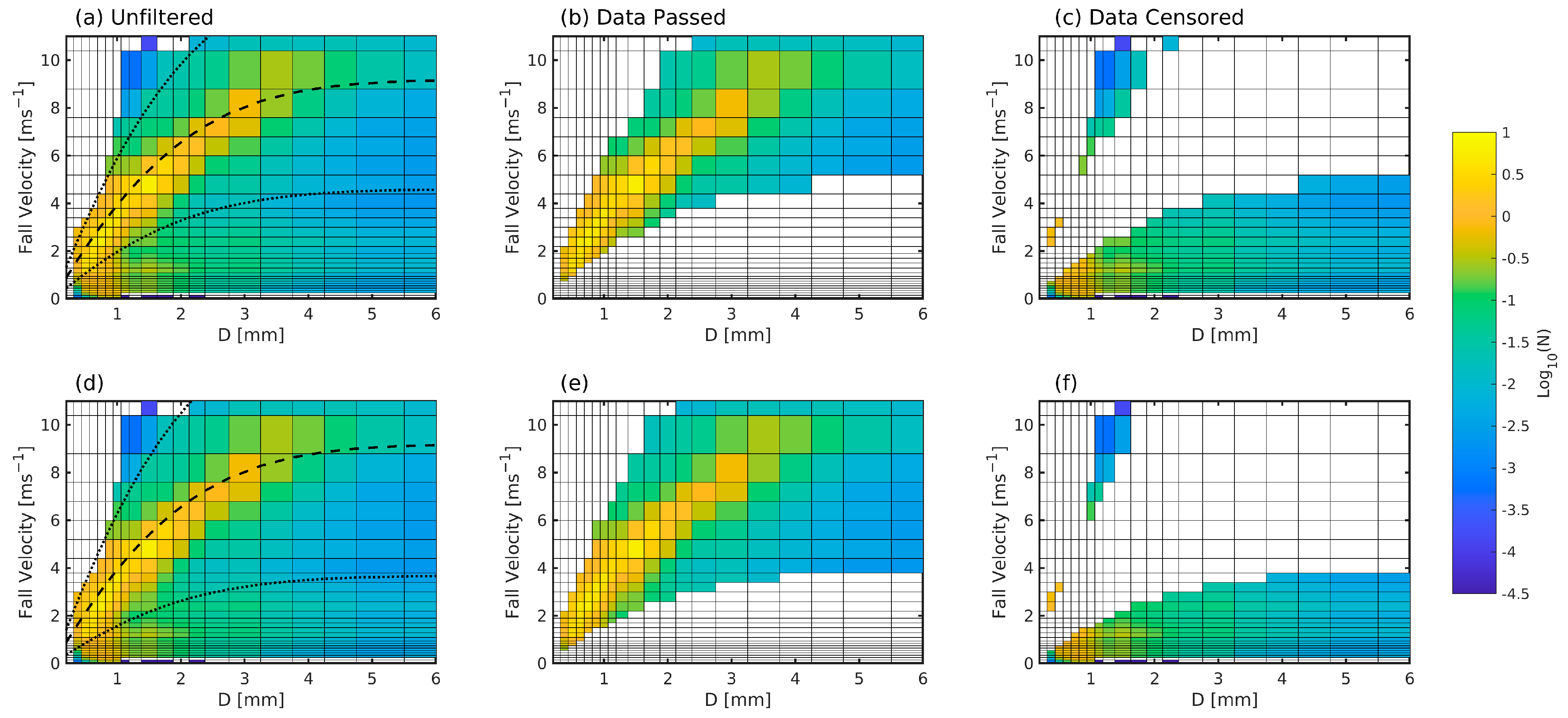



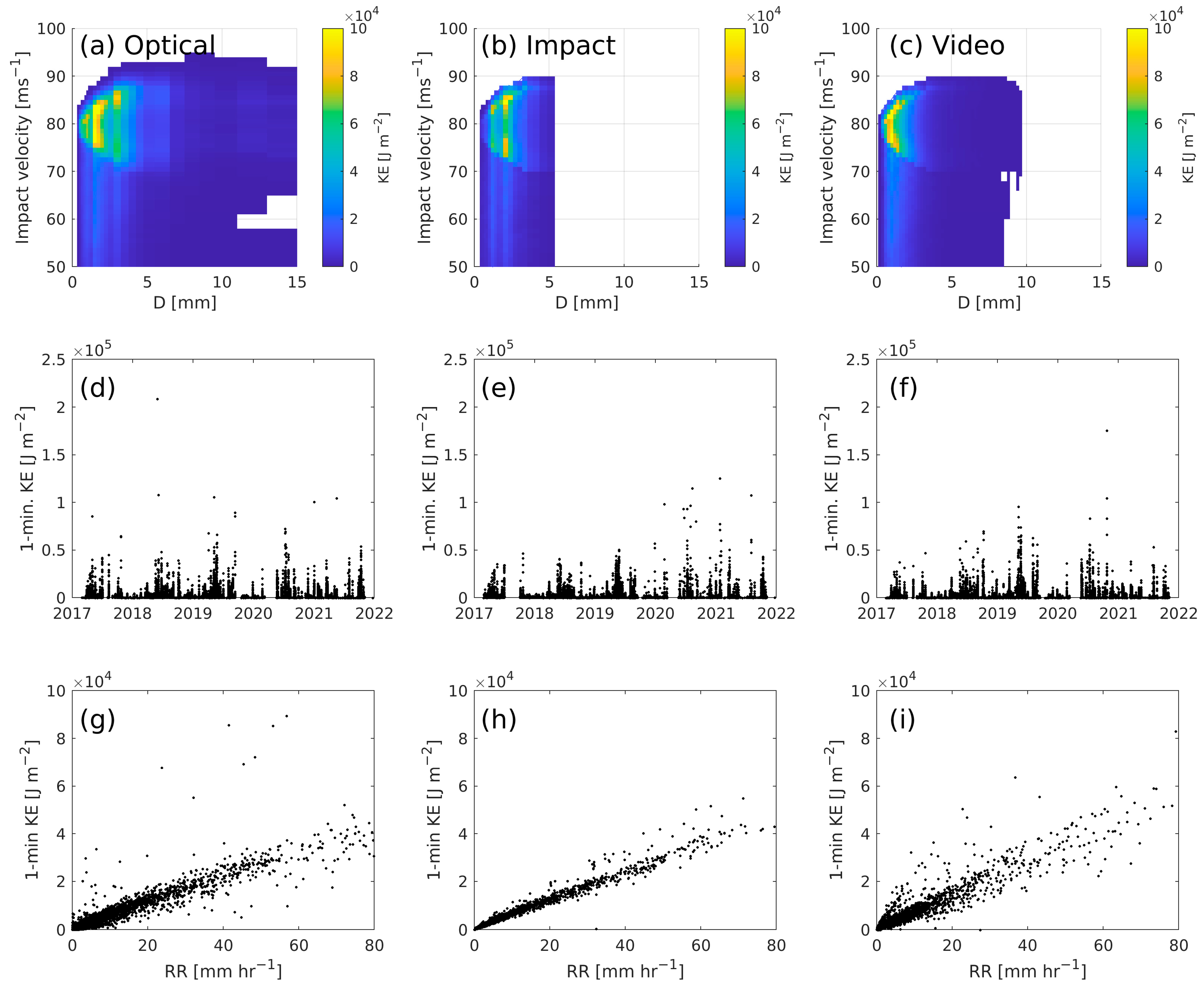
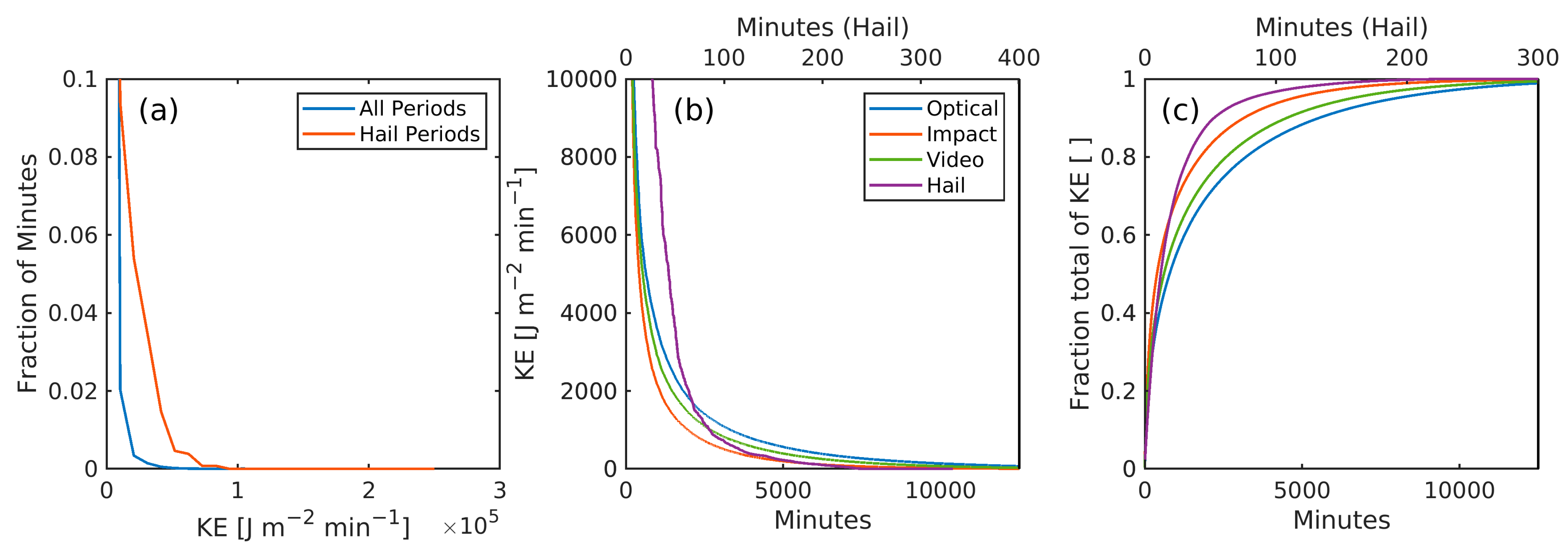
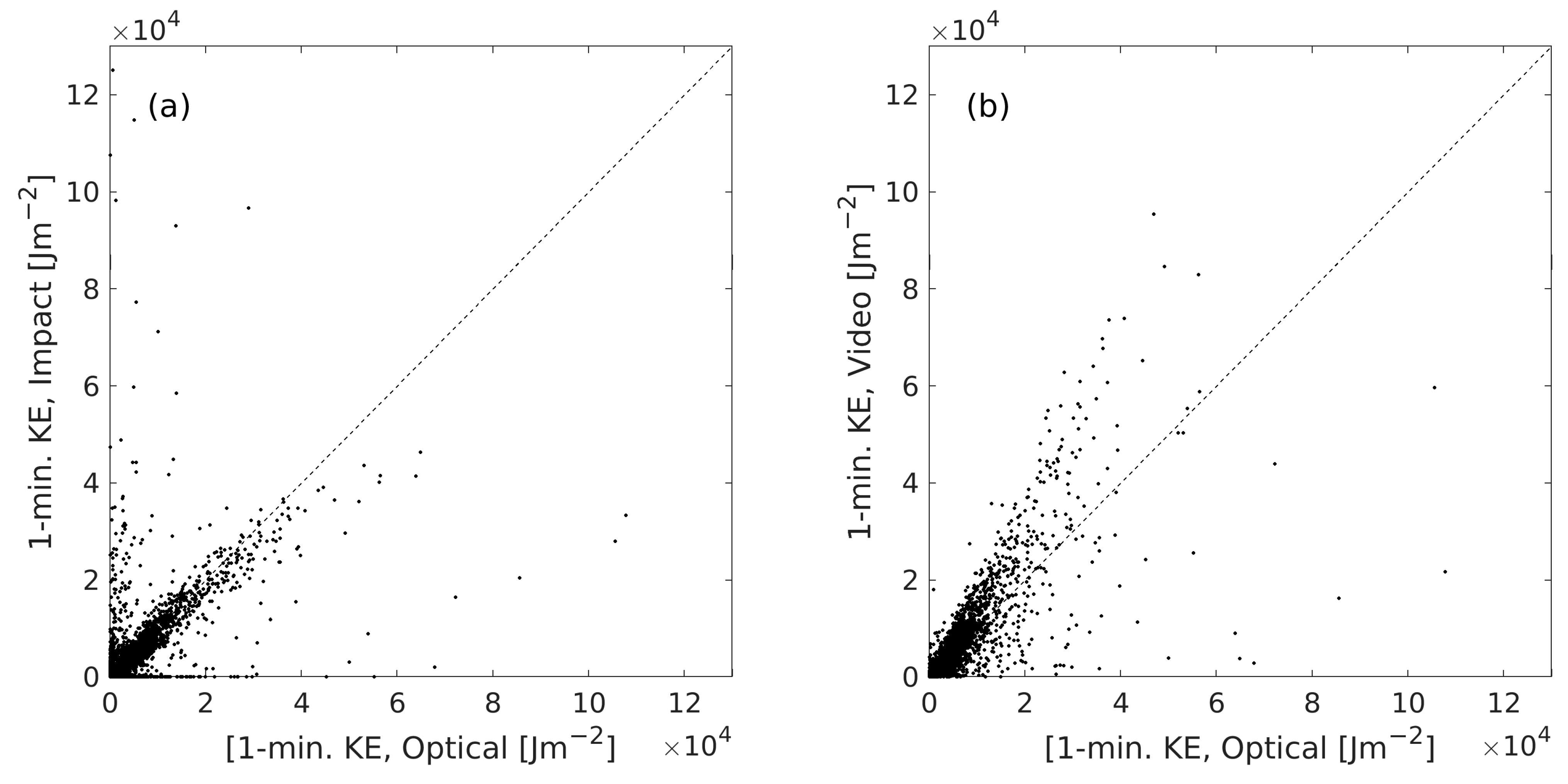


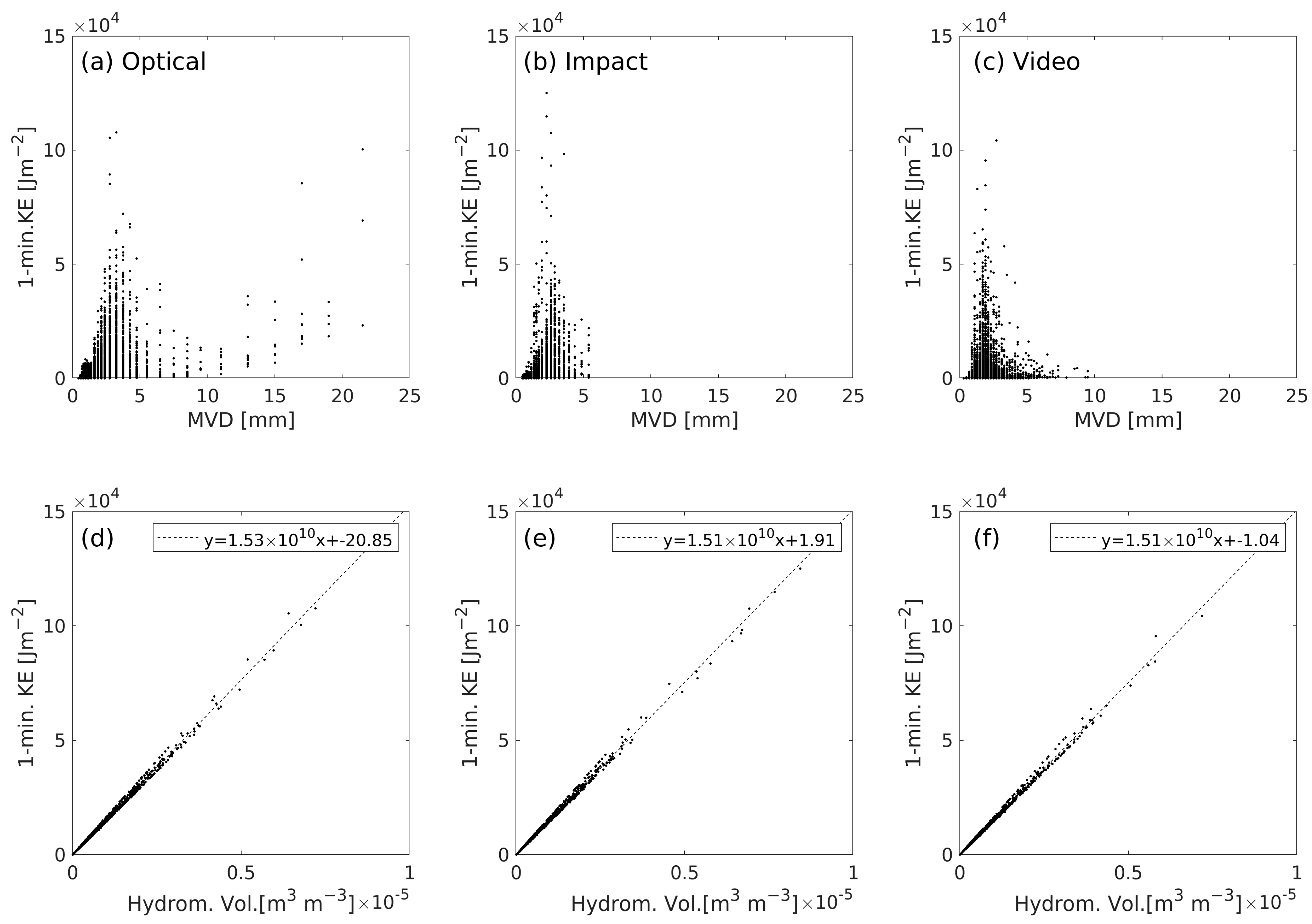
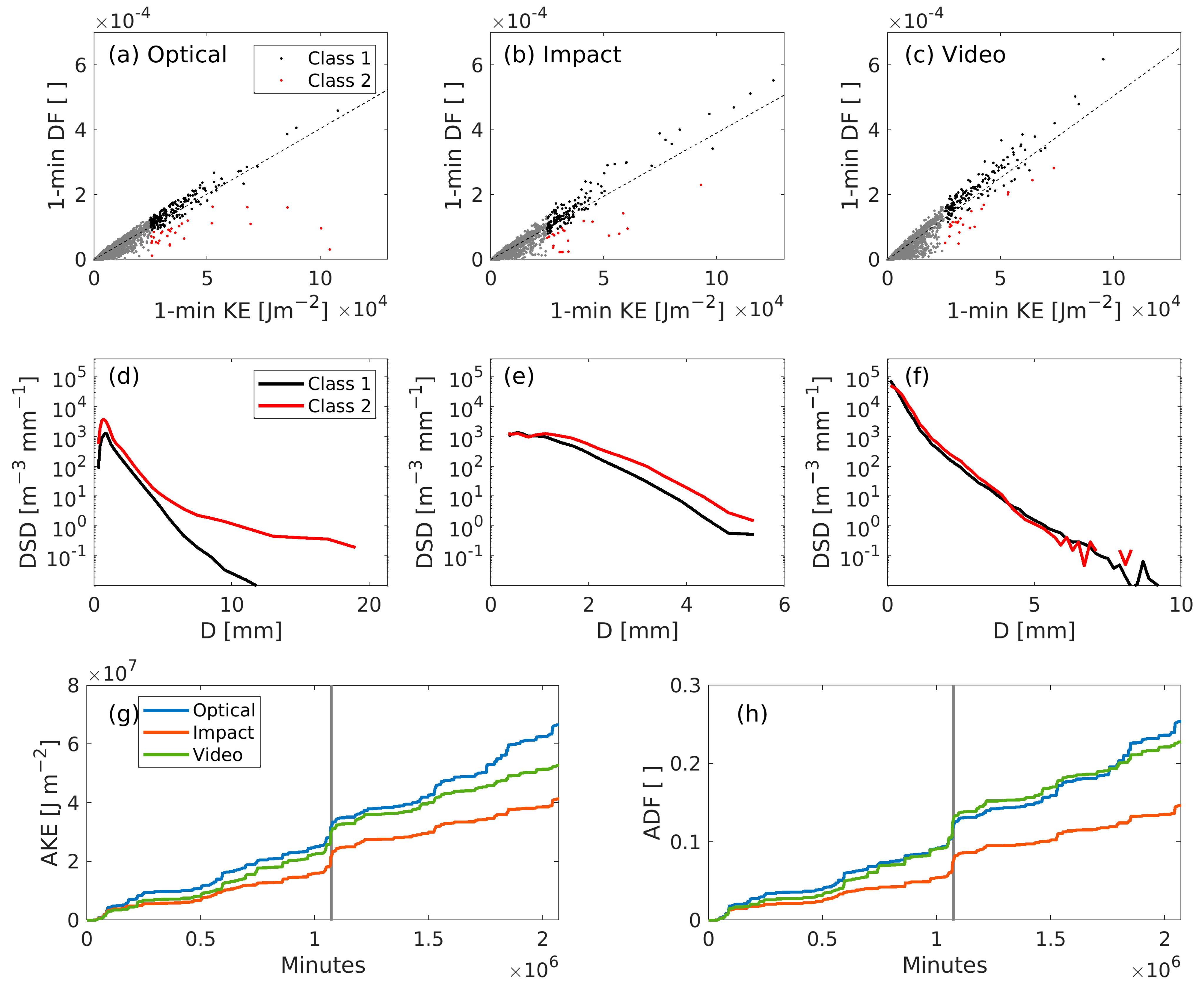
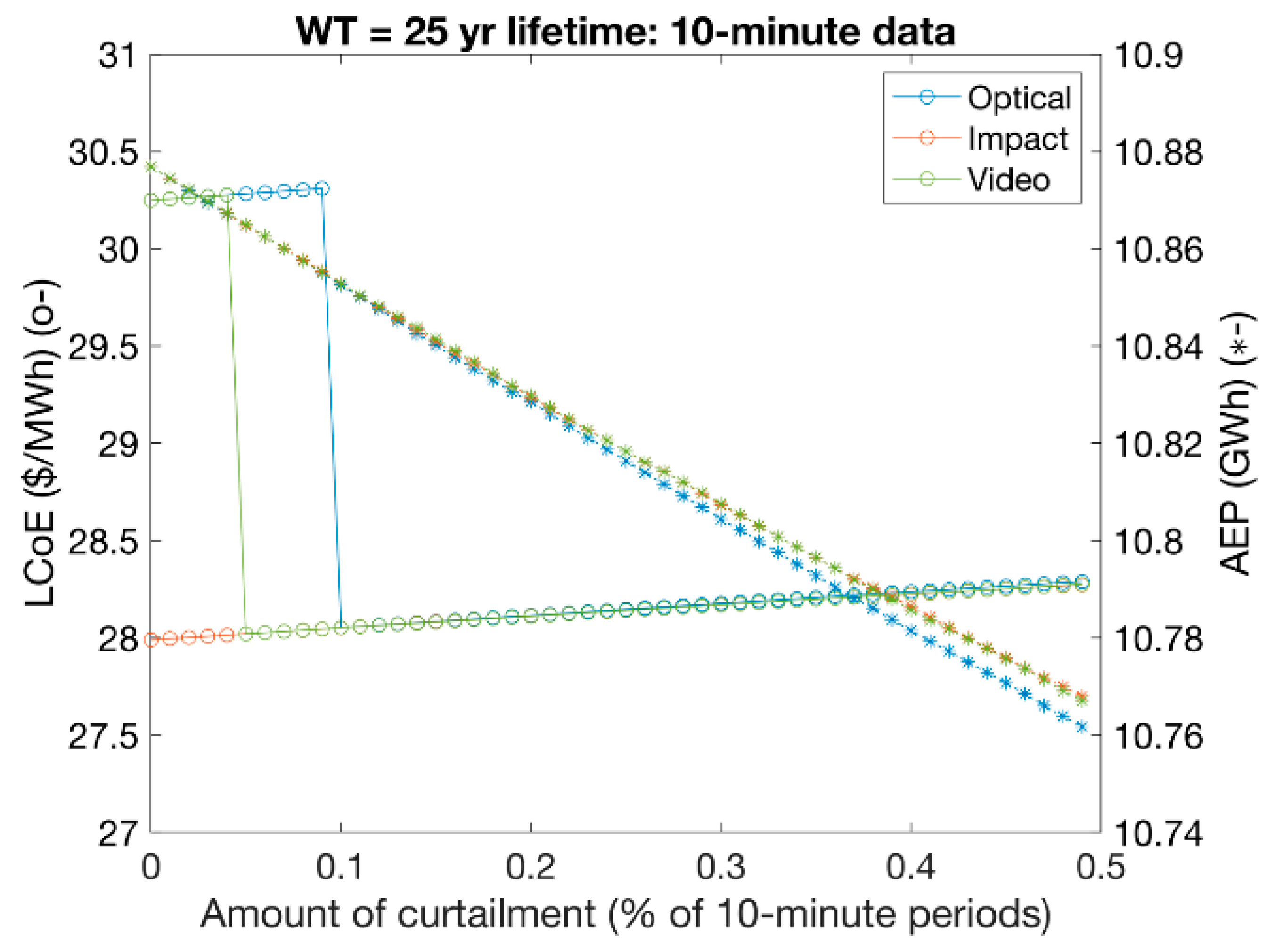

| Variable | Symbol | Value | Unit | Source |
|---|---|---|---|---|
| Coating Poisson ratio | 0.295 | - | [17] | |
| Coating density | 1690 | kg m−3 | [17] | |
| Coating ultimate tensile strength | 1.30 × 107 | Pa | [17] | |
| Coating endurance limit | 6.30 × 106 | Pa | [17] | |
| Coating fatigue knee | 16.52 | - | [17] | |
| Substrate density | 1930 | kg m−3 | [17] | |
| Liquid density | 997 | kg m−3 | [53] | |
| Liquid acoustic velocity | 1481 | ms−1 | [53] | |
| Impact angle | 0 | Degrees | [53] | |
| Coating thickness | 750 × 10−6 | m | [53] | |
| Springer Constant a1 | 7 × 10−6 | - | [53] | |
| Springer Constant a2 | 5.7 | - | [53] | |
| Coating acoustic velocity | 1730 | m s−1 | [17] | |
| Substrate acoustic velocity | 2390 | m s−1 | [17] |
| Optical | Impact | Video | Hail Periods (Optical) | Optical (±60% Filter) | |
|---|---|---|---|---|---|
| Total KE [J m−2] | 6.66 × 107 | 4.14 × 107 | 5.28 × 107 | 6.33 × 106 | 7.63 × 107 |
| Minutes with KE > 0 | 90,067 | 114,815 | 115,499 | 1331 | 90,067 |
| Fraction of Minutes at Rated U | 0.241 | 0.171 | 0.180 | 0.502 | 0.241 |
| Estimated Lifetime from Springer Model [years] | 15.7 | 27.2 | 17.5 | 13.8 |
| Slope | Intercept | Pearson r | Mean (DF)/Mean (KE) | N (Class 1) | N (Class 2) | |
|---|---|---|---|---|---|---|
| Optical | 4.04 × 10−9 | −7.34 × 10−9 | 0.955 | 3.81 × 10−9 | 200 | 29 |
| Impact | 3.91 × 10−9 | −7.35 × 10−9 | 0.960 | 3.54 × 10−9 | 152 | 23 |
| Video | 5.05× 10−9 | −18.6 × 10−9 | 0.962 | 4.32 × 10−9 | 155 | 23 |
Disclaimer/Publisher’s Note: The statements, opinions and data contained in all publications are solely those of the individual author(s) and contributor(s) and not of MDPI and/or the editor(s). MDPI and/or the editor(s) disclaim responsibility for any injury to people or property resulting from any ideas, methods, instructions or products referred to in the content. |
© 2023 by the authors. Licensee MDPI, Basel, Switzerland. This article is an open access article distributed under the terms and conditions of the Creative Commons Attribution (CC BY) license (https://creativecommons.org/licenses/by/4.0/).
Share and Cite
Letson, F.; Pryor, S.C. From Hydrometeor Size Distribution Measurements to Projections of Wind Turbine Blade Leading-Edge Erosion. Energies 2023, 16, 3906. https://doi.org/10.3390/en16093906
Letson F, Pryor SC. From Hydrometeor Size Distribution Measurements to Projections of Wind Turbine Blade Leading-Edge Erosion. Energies. 2023; 16(9):3906. https://doi.org/10.3390/en16093906
Chicago/Turabian StyleLetson, Fred, and Sara C. Pryor. 2023. "From Hydrometeor Size Distribution Measurements to Projections of Wind Turbine Blade Leading-Edge Erosion" Energies 16, no. 9: 3906. https://doi.org/10.3390/en16093906
APA StyleLetson, F., & Pryor, S. C. (2023). From Hydrometeor Size Distribution Measurements to Projections of Wind Turbine Blade Leading-Edge Erosion. Energies, 16(9), 3906. https://doi.org/10.3390/en16093906








